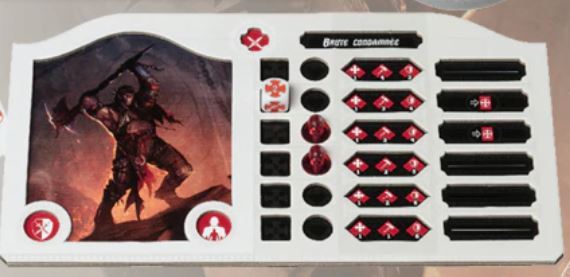February 1543, and deep in the throes of the reformation sundering Europe, a radical religious sect of Anabaptists seizes the walled Westphalian city of Münster. Christened after their founding prophet, these Melchiorites assign themselves as God’s chosen elect, and set about the foundation and fortification of their communal sanctuary – their promised New Jerusalem.
In the years that followed, a siege besets the town as both Papal and Lutheran forces seek to snuff their impudence, and the faithful descend into a piteous cult besmirched by violence, paranoia, and ultimately cannibalism – their new Jerusalem morphing into a soiled mockery that would shame Sodom itself.
100 years later to the day, a new cadre of believers erect the foundations of their own New Jerusalem, driving their spike upon the shores of the river Styx itself. And as it was a century prior, their hubris does not go unchallenged. With the spires and crenelations of their shining city edging deeper into the underworld – trembling voices expound rumour of pyroclastic flows, impious inhabitants, and a troglodytic race that seeks to halt their advance – by hook, by crook, by grizzled tooth and claw.

Such blasphemies must be answered of course, and so we are enlisted to purge the cloying depths – the poor, the damned, the desperate. Pressed into service, we advance by flickering lamplight – to unravel, to expand, to purge and redeem.
To die wailing in the dark.
But we will not go softly to our doom.

There’s one in every gaming group. The player that relishes gleefully in grinding their opponent mercilessly into the dirt, cackling manically as every tumbling die or splayed deck brooks further hideous predation. Even when the outcome is clear, they’re loathe to call a halt, not content to cease until an opponent’s every ambition is snuffed in a grim endgame whilst they wallow in the folds of euphoric schadenfreude.
Conversely, there exists the masochistic mindset that seeks to pit their wit and will against seemingly insurmountable odds. The player that revels in overcoming the overwhelming as they puzzle out the perilous path that will lead to victory snatched breathlessly in the dying minutes to midnight. Magnanimous in defeat, they plead for further debasement as the stakes are reset.
It’s all very consensual of course.
When this duo collide over a table arrayed with the contents of Monolith’s Claustrophobia 1643, fasten tight the windows for the squall of a perfect storm.

At first glance, Claustrophobia 1643 looks to be the kind of product I’m increasingly wary of as my relationship to the gaming hobby evolves. An imposingly weighty box rammed to the gills with modular content- it intimidates as it throws shadows over the table. It seems like a lot, and it is – but as we dirty our nails in the dig through its crypts, it is delight and not despair that we unearth.
It certainly helps that this is not your average big box Kickstarter affair. As the evolution of a venerated relic, 1643 has the advantage of building upon the firmament of the much loved original 2009 edition, encompassing its numerous expansions, tweaking its components and incorporating lessons learned over a decade of play. The result is a game that sings with a supreme confidence, is simple enough to settle into swiftly and yet offers a baited hook for repeat plays that is nigh-impossible to resist.

And yeah, whilst there is a lot of stuff in this box, it’s beautiful stuff, and what is more- it’s wildly functional stuff. Every component has been crafted with a mechanism in mind to lend the experience an ease and flow that will likely see you forgive its indulgences, even as it crowds your table beneath its creeping sprawl.
A resource management and allocation affair at its core, it’s the dice placement system comprising the generation of those resources that is 1643’s genius. There’s something oddly satisfying about dice-placement as a mechanism. Slotting those bones into their snug slots is both a tactile and cerebral delight, but when it is married to thematic coherence as astutely as it is here then it ascends to a whole new level of inspired design.
Embodying the roles of either the Western Warriors of New Jerusalem or the demonic hordes they have disturbed in their expansionism, players will muster and deploy their forces throughout a series of scenarios in which the odds are generally tilted firmly against the fallible frames of the fleshy intruders.
Sat behind an expansive selection of dashboards, players will take turns rolling and allocating their dice into a sequence of slots that will determine their possibilities for the round to come. The doomed forces of the western crusaders are tasked with a series of scenario dependent gauntlets to vault, whilst their demoniac opponent is rarely troubled with any milestones to measure beyond dispatch and destroy.

Each of the westerner’s zealots have six slots, numbered to reflect the associated side of a diminutive D6, and which will determine their movement, attack and defensive capabilities for the turn. On top of this, certain slots will gift the bonus of a skill card or player power to further bolster them in their descent. Options are plentiful at first, as players throw fistfuls and pore over their options, maximising their abilities and affinities for the melee to come. It is only once blood begins to flow that things become truly interesting though.
With every strike they suffer, the warriors will have to assign a wound to one of the crevasses in question, rendering it moot and thus strangling their slots. As further blows rain down they will watch as their options dwindle in response to the assault, the weary warriors slowly but surely succumbing to their injuries. Should the player be forced to assign a die to a wounded slot – that warrior becomes exhausted for the round, rendering them immobile, unable to attack and with only the most rudimentary defensive options at their disposal.
It is in this dreadful winnowing process that the titular feeling of Claustrophobia is most chillingly evoked as desperation mounts and a far more judicious use of resources is called for, the weight of each roll hanging heavy as players prays for deliverance, or at least the option to launch a reprisal or take flight from their predicament.

The abyssal player conversely, has access to near-limitless throngs of fiendish fodder to call upon. These scurrying legions of Troglodytes are punctuated with the limited use of more terrifying thralls – fearsome hellhounds and a range of demonic princes, each replete with their own selection of dread majicks. They too will be assigning dice to activate powers, draw cards and gain Prima Materia- the currency with which they will conjure their army of aberrations. Their task then is to corral and control, harnessing a deft combination of harrying fodder units and chokepoint-funnelling grand horrors to best hem and halt the advance of the warriors as they struggle towards their objectives.
This succession of clashes will play out across an unfolding array of beautifully illustrated modular tiles, peppered throughout with situational circumstances and generous enough in number to ensure a dizzying array of potential labyrinths to plumb. The tilt of the tiles can wildly upend proceedings here, as they dictate deployment options for the infernal player. Canny warriors will divide their beleaguered forces to deny entry to the denizens of the pit at critical junctures, all whilst racing to fulfil their objective, well aware that attrition of any stripe will not favour them in these blighted chambers.

There’s a certain purity to the 1v1 competitive game. It engenders a focus that eludes a more crowded tablespace. Two enter, one leaves. Grudges escalate, the pendulum swings and an unbidden admiration blossoms even in the throes of capitulation. Claustrophobia 1643, with its combination of tactical management, evolving playspace and contingent response to dice-based fate is perhaps an apogee example of this kind of affable rivalry experience, with the hand of lady luck leavening the despondency that defeat can oft bring. Each crusade into the depths is unlikely to outstay its welcome either, meaning you’re likely to switch sides and go at it again, further balancing the scales of triumph and retribution.
With twenty scenarios in the base game, all of which can experienced anew from the opposing angle, and a generous selection of infernal fiends to lend further variety, Claustrophobia 1643 is a game that has taken up residence on my table for weeks now, and in the aftermath of each clash it continues to crowd my psyche as I replay the events that led to dour defeat or sainted succession. It captures the desperate, harrowing, claustrophobic environs of the underworld like few other titles, and whether you choose to inhabit the begrimed boots of pious pilgrims or the satanic sinews of their tormentors it offers an experience that enthrals as it both enervates and infuriates with every twist and turn.
If you like it down deep in the dirt and the dark, I can think of few better places for you to play.
Thankyou ma’am. May I have another?

 Games
Games How to resolve AdBlock issue?
How to resolve AdBlock issue? 



















